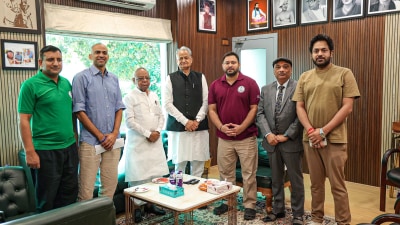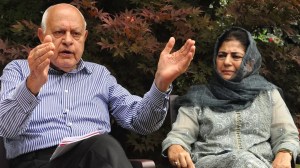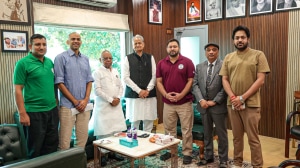He sees the future here
‘‘PUNE is a better city than Bangalore.’’ The thumbs-up from N R Narayana Murthy, Corporate India’s most well-known...

 ‘‘PUNE is a better city than Bangalore.’’ The thumbs-up from N R Narayana Murthy, Corporate India’s most well-known face, isn’t just lip-service. For, outside Bangalore, IT bellwether Infosys’s biggest development centre is located in Pune, at the sprawling Hinjewadi Software Technology Park, Phase I.
‘‘PUNE is a better city than Bangalore.’’ The thumbs-up from N R Narayana Murthy, Corporate India’s most well-known face, isn’t just lip-service. For, outside Bangalore, IT bellwether Infosys’s biggest development centre is located in Pune, at the sprawling Hinjewadi Software Technology Park, Phase I.
What’s more, both Infosys and IT giant Wipro, which also has a huge centre in Phase I, have acquired land in Hinjewadi Phases II (where Infosys is investing Rs 250 crore) and III.
IT’s all happening in Pune. From IT top guns Infosys, Wipro, TCS, Cognizant to BPO biggies WNS, EDS, EXL, Convergys, Avaya, Aviva, Xansa, MsourcE, everyone appears to be making a beeline for the city. In the past few months itself, there has been a rush of funds: 56 IT companies have registered themselves with the Software Technology Park of India (STPI) between April and September, including Avaya, which is opening its second centre in Pune.
Nor is BPO the only engine driving this boom. White goods major LG Electronics is investing $60 million in a state-of-the-art plant at Rajnandgaon, near Pune, which will produce 20 million units of GSM mobile phones by 2010, 50 per cent of them for export.
But it is undoubtedly the BPO bullishness that is breathtaking. The $20 billion global giant EDS has opened its second solution centre facility at private IT park Magarpatta; Veritas Software is spending $50 million on its biggest R&D centre outside the US in Pune; global telecom solutions major Cable & Wireless is pouring $1.5 million into Pune to service growing BPO clientele; Cisco Systems is spending $1.25 million on start-up CXO Systems; MsourcE is adding 900 more in six months to take Pune headcount to 3,000, the upper limit for any centre.
IS PUNE READY?
WITH Pune attracting so much attention, some of it invariably spills over to infrastructure—or the lack of it. Every time Nasscom president Kiran Karnik comes to the city, for instance, he expresses displeasure with the lack of transport facilities. Add to that potholed roads, poor power supply—Pune city suffers a shortfall of 10-15 per cent—chaotic traffic, pollution, haphazard growth, no international airport and the chances increase of Pune going the Bangalore way for all the wrong reasons (see box).
|
Story continues below this ad
|
Pune Municipal Commissioner Nitin Kareer admits that a lot is at stake. ‘‘My priority is improving the roads network and connectivity,’’ he says, adding that the right signals have to be sent to the investors flocking to the city.
That said, in 2003-04, software exports from Pune touched Rs 4,200 crore (from Rs 2,800 crore in 2002-03), and according to ‘‘modest’’ STPI estimates, it will jump 45 per cent next year.
THE R&D LINK
PUNE also specialises in high-end software development, like CAD/CAM design, and is slowly gaining a foothold in global R&D as well. ‘‘Every Veritas product will soon have a Pune tag,’’ says Veritas India MD Sharad Sharma.
True, the Intels, Motorolas, Texas Instruments of the world are in Bangalore, but the rich talent pool and the proximity of IIT Powai are attracting start-ups in hordes. For every development centre set up here by a US-headquartered business (Nevis Networks, IdeaS, Ensim etc), there are home-grown product companies like Persistent Systems, Compulink, Softlink, KPIT Cummins, CashTech, which are growing from strength to strength as well.
To accommodate them all, three government-initiated software technology parks are coming up, along with at least five massive private IT parks.
WHY THE BOOM
THE list of businesses that swear by Pune raises quite a few eyebrows—not surprising, considering that as late as August 2002, a Nasscom-Netscribes study on the ITES/BPO sector had ranked the city a lowly ninth as an IT destination.
So what led to the turnaround? Many factors, according to Murthy. ‘‘With Pune being an educational hub (it has a 3.5 lakh student population], there is never a shortage of manpower. The weather is great, even the traffic not as bad as in Bangalore.’’
For Pune-based Partha Iyengar, VP, Gartner Inc., the biggest draw is the ‘‘small-town atmosphere with big city amenities’’ And lower rates of attrition, world-class standards, easy approvals, top R&D centres and laboratories like National Chemical Laboratory, C-DAC and DRDO.
When Ram Pazhayannur, head of business development at Persistent Systems, relocated from the US, he was bowled over by the ‘‘Silicon Valley-type dynamism in the workspace and the quality of life at lower costs’’. Ditto John O’Halloran, who moved from the US to head the Cummins Research and Technology India. ‘‘Being here in Pune is all value.’’
THE MIDAS TOUCH
THE IT wave has had a palpable spillover effect. From real estate to hospitality, reverse migration (of software engineers) to mushrooming of malls-and-multiplexes, Pune is cashing in.
For example, hotels (Pune has only 500 five-star rooms), where occupancy dipped to as low as 40 per cent last year, are all full-up—so much so a practice match of India A versus India ahead of the Australia series had to be passed on to Bangalore due to ‘‘paucity of hotel rooms’’. Sniffing opportunity, city builders are coming up with five five-star hotels in three years, spending Rs 20-40 lakh per room.
With disposable incomes rising, the real estate boom which began over the last decade shows no sign of ebbing. Leading the way is the residential sector, which constitutes almost 82 per cent of the Rs 3,400-crore industry, while the office and the retail sector have an equal share of 9 per cent each.
‘‘Close to 2.07 million sq ft of space is under construction or just completed in Pune city. We expect the prices to remain steady over the next six months,’’ says property consultants Knight Frank.
ON AUTO MODE
BUT the biggest buzz is in manufacturing, ‘‘the mother of all industries,’’ as Sanjiv Bajaj, executive director, Bajaj Auto, puts it. With all indicators suggesting a global economic recovery, the smiles are back in the auto hub of Pune. The Centre has just cleared a Rs 67-crore auto cluster project—India’s first—for Pimpri-Chinchwad.
For Bharat Forge CMD Baba Kalyani, the turnaround couldn’t have come at a better time. ‘‘Contrary to popular perception, the increasing role of outsourcing in an integrated global economy is not limited to IT,’’ he says. ‘‘In fact, I will stick out my neck to claim that the potential for growth of global outsourcing in manufacturing could well outstrip that in the IT and IT-related services.’’
As the largest exporter of auto components to the US, China and Europe in 2003-04 (worth Rs 333 crore), BFL, the second largest forging company in the world after acquiring German company Carl Dan Peddinghaus this January, can afford to talk.
Not surprisingly, major auto players Tata Motors, Bajaj Auto, Kinetic Motor, Daimler Chrysler India, Mahindra & Mahindra and other engineering majors like Kirloskar Brothers, Kirloskar Oil Engines, Thermax are all increasing their global footprint.
In 2003-04, Bajaj Auto exports grew by 69 per cent, accounting for over 156,000 vehicles. ‘‘International markets will be a key driver of our sales in future,’’ admits Rahul Bajaj, CMD, Bajaj Auto. For Kinetic Motor CMD Arun Firodia, the jump in exports is the biggest indicator that ‘‘we have come of age’’.
The favourite word in manufacturing circles today is ‘‘ramp-up’’. Tata Motors, which produces 450 cars everyday at its swank facility at Pimpri-Chinchwad, will increase it to 750 a day by March to ‘‘clear the heavy backlog of the Indigo and Indica’’, says Dr V Sumantran, Executive VP, Tata Motors.
As Meher Pudumjee, who took over as chairperson of Thermax this month from mother Anu Aga, puts it: ‘‘The biggest challenge is the buoyancy in the market, and how we leverage it.’’
Will Pune be Bangalored?
Infrastructure continues to be the soft underbelly for the aspiring IT capital
Bangalore’s 3,000 km of roads are narrow, congested and potholed. Power cuts are frequent, pollution levels high. Says Wipro vice-chairman Vivek Paul, ‘‘It is becoming increasingly difficult to sustain growth in Bangalore. We want to move much of our incremental growth out of Bangalore.’’
Pune would love to be the alternate destination of choice. But, says Ganesh Natarajan, CEO, Zensar Technologies: ‘‘To avoid getting into situations like that of Bangalore, Pune will certainly have to pull up its socks when it comes to facilities like road conditions, intra-city connectivity as well as power supply.’’
To make quality goods, manufacturing needs uninterrupted power supply, points out Atul Kirloskar, CMD, Kirloskar Oil Engines.
It’s not that Pune Municipal Commissioner Nitin Kareer is unaware of the problems of plenty. ‘‘Our topmost priority is to improve the road network… we want to upgrade and beautify all entry roads into Pune; and also open up new areas of development by first building a road.’’ For the ambitious project, PMC is taking a loan of Rs 200 crore and also trying to tap public-private partnership.
But that’s easier said than done. The Maharashtra State Road Development Corporation (MSRDC) had drawn up a Rs 260-crore project to improve roads. The project was sanctioned almost seven years ago. But so far MSRDC has completed only one flyover; another is in progress. The reason is not far to seek: MSRDC is in the red.
The other focus area for Kareer is the transport system. ‘‘Pune and Pimpri-Chinchwad together have a population of 4 million… we need a mass transit system, either skybus, metro, light rail.’’
He also has ambitious plans to turn around the beleaguered Pune Municipal Transport system. ‘‘We will increase the fleet to 1,400 or so, but we have to plan beyond that.’’ With rickety buses being the order of the day and roads seemingly under construction (Pune-Mumbai highway) for ever, all eyes are on Kareer and Co.





- 01
- 02
- 03
- 04
- 05


























